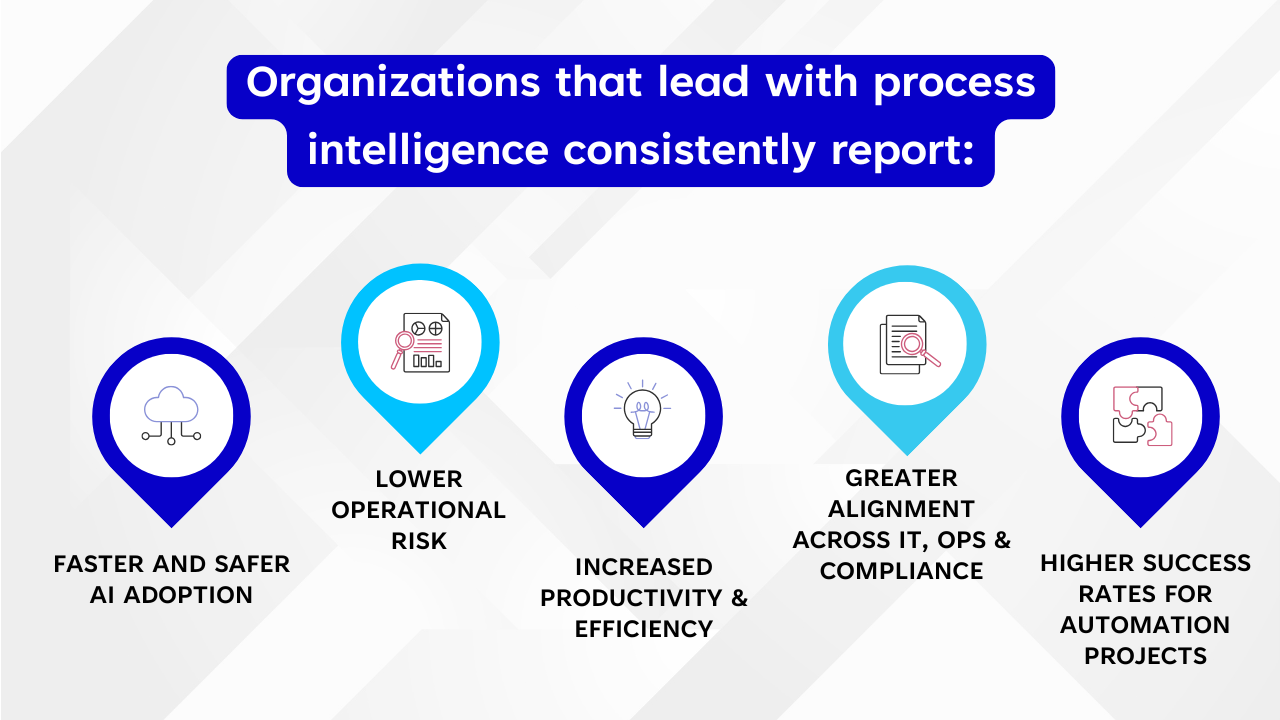AI Isn’t a Starting Point—It’s a Multiplier
Enterprise teams across industries are investing heavily in artificial intelligence—whether it’s generative AI, agentic AI, or automation tools. But there’s a common and costly misconception: that AI is a silver bullet for inefficiency. In reality, AI doesn’t solve operational problems, it amplifies whatever foundation is already in place.
If your current processes are undocumented, inconsistent, or riddled with bottlenecks, layering AI on top can actually accelerate dysfunction. You can’t automate what you don’t understand, which is why process intelligence is the critical first step. It provides the transparency, structure, and foresight teams need to make AI successful.
What Process Intelligence Really Means
Process intelligence is more than a buzzword. It’s the discipline of uncovering how work actually happens across your organization – using real data – not assumptions or outdated SOPs. Through capabilities like process mining, modeling, and simulation, teams can surface inefficiencies, visualize end-to-end execution, and design better ways of working.
This level of visibility isn’t just helpful, it’s essential for AI readiness. Without it, you’re guessing at where automation belongs or how AI agents might behave inside a given workflow. With it, you gain control: you can test, measure, and plan with confidence.
Why Skipping to AI Introduces Risk
When organizations jump into AI or automation initiatives without process intelligence, they often discover problems the hard way. Automation ends up accelerating broken steps. AI agents bypass critical controls. Data quality issues surface late. Worse, the promised ROI fails to materialize because the project was built on flawed assumptions.
These challenges aren’t caused by AI itself. They’re symptoms of an unprepared environment. AI is only as good as the structure you place around it, and that structure starts with understanding your current processes.
What AI Readiness Really Looks Like
AI readiness isn’t about how many pilot projects you’ve launched. It’s about whether your organization has the operational clarity to introduce intelligent automation safely and effectively. At a minimum, that means having:
- A clear picture of how current processes run, including any existing automation.
- Defined variations, dependencies, and decision points. Process Mining helps here.
- Models of your manual tasks/activities and your ideal future-state processes
- Simulations that test what happens if you automate or introduce AI at key steps
- Governance in place to manage risk, compliance, and exceptions.
- A centralized process repository to map interdependencies and prevent unintended impacts across processes.
These aren’t “nice to haves”, they’re prerequisites for success in a world of agentic AI and adaptive automation.
Simulate First. Automate Second.
Take a scenario like invoice processing. Before introducing AI to automate approvals, you’ll want to know how long each step takes, how often exceptions occur, and whether approvals are frequently overridden. You’ll also want to test how AI would affect cycle time, accuracy, and downstream processes like audit reporting.
This is exactly what process simulation enables. It lets teams preview outcomes, compare automation strategies, and predict the business impact of a change, without deploying risky experiments in production. It’s the safety net that transforms AI from a gamble into a strategy.
Here are a few questions you could use simulation to answer:
- Will introducing AI or automation eliminate the bottleneck, or just move it? Simulation reveals whether the automation accelerates the process or simply shifts the delay to a downstream task or team.
- How will AI or automation impact overall cost, cycle time, and resource allocation? Forecast whether automation will reduce manual effort, increase throughput, or have other expected impacts.
- What sort of impact might AI decision-making have? Use simulation to perform variability or contingency-planning analysis, such as predicting error rates with AI or automation, and its impact on the rest of the process and resources.
- Will the change help us meet our strategic KPIs—like SLA adherence, productivity, or customer satisfaction? Compare simulated outcomes across different automation levels to see if AI improves the metrics that matter.
- Which automation scenarios deliver the highest ROI with the lowest operational risk? Simulate multiple configurations (e.g., full automation vs. hybrid AI + human) to identify the optimal approach for both performance and governance.
Agentic AI Demands Operational Clarity
Agentic AI – AI that can take initiative and make decisions on behalf of the organization – offers enormous potential. But it also introduces new levels of complexity, autonomy, and risk. To operate safely and effectively, these intelligent systems need more than just access to data—they require a well-documented, well-governed operational environment.
That means organizations must have clear, structured processes in place. Process documentation must go beyond basic flowcharts. It should define inputs, outputs, exceptions, and conditions for action. Risks and controls must be mapped and monitored to ensure decisions made by AI remain within the bounds of regulatory and internal policy requirements.
Without this foundation, agentic AI can make choices that diverge from compliance standards or business intent—not because it’s flawed, but because the operational context was never clearly defined. Process intelligence fills that gap by giving teams the tools to document real-world execution, track deviations, and simulate how agentic behavior could impact performance, risk, or compliance.
Operational clarity isn’t a nice-to-have—it’s a prerequisite for safely scaling autonomous decision-making.
What Teams Gain When They Start with Process Intelligence
Organizations that lead with process intelligence consistently report stronger outcomes. They adopt automation faster, with fewer surprises. They meet compliance requirements more easily. They align IT, ops, and business stakeholders on a shared operational blueprint. And most importantly, they achieve the productivity and performance gains AI promises—because they’re starting from a position of clarity.
Discover, Design, Optimize: The iGrafx Approach
At iGrafx, we help organizations build AI-ready operations using a proven three-phase framework:
- Discover
Uncover how your processes actually run using process and task mining. Eliminate assumptions and see where time, cost, and risk live in the real world.
- Design
Create detailed models of your ideal future-state processes, incorporating automation, AI, compliance rules, and roles across departments.
- Optimize
Simulate changes before implementation, test different AI strategies, and continuously refine performance based on live data.
This structured approach reduces risk, increases agility, and prepares your organization for scalable, intelligent automation.
Final Thought: You Can’t Automate What You Don’t Understand
AI will continue to reshape business. But it’s not a shortcut to process excellence, it’s an amplifier of what already exists. If your processes are slow, fragmented, or undocumented, AI will only highlight the problem faster.
Process intelligence gives you the insights, control, and foresight to make smart decisions about where and how to apply AI. Start there, and you’ll build automation that actually delivers on its promise.
If you’re ready to see what a modern process intelligence platform can do to ensure success with AI and automation, we invite you to book a personalized demo or contact the iGrafx team.


